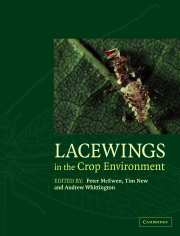Book contents
- Frontmatter
- Contents
- List of contributors
- Preface
- PART 1 Lacewing systematics and ecology
- PART 2 Lacewings in crops
- PART 3 Principles
- Introduction to Part 3
- CHAPTER 11 The use of lacewings in biological control
- CHAPTER 12 Mass-rearing, release techniques, and augmentation
- CHAPTER 13 Features of the nutrition of Chrysopidae larvae and larval artificial diets
- CHAPTER 14 Ecological studies of released lacewings in crops
- CHAPTER 15 Sampling and studying lacewings in crops
- CHAPTER 16 Interactions with plant management strategies
- CHAPTER 17 Lacewings, biological control, and conservation
- PART 4 Case studies
- PART 5 Conclusion
- Taxonomic index
- General index
CHAPTER 12 - Mass-rearing, release techniques, and augmentation
Published online by Cambridge University Press: 04 May 2010
- Frontmatter
- Contents
- List of contributors
- Preface
- PART 1 Lacewing systematics and ecology
- PART 2 Lacewings in crops
- PART 3 Principles
- Introduction to Part 3
- CHAPTER 11 The use of lacewings in biological control
- CHAPTER 12 Mass-rearing, release techniques, and augmentation
- CHAPTER 13 Features of the nutrition of Chrysopidae larvae and larval artificial diets
- CHAPTER 14 Ecological studies of released lacewings in crops
- CHAPTER 15 Sampling and studying lacewings in crops
- CHAPTER 16 Interactions with plant management strategies
- CHAPTER 17 Lacewings, biological control, and conservation
- PART 4 Case studies
- PART 5 Conclusion
- Taxonomic index
- General index
Summary
INTRODUCTION
The family Chrysopidae contains some 90 genera or subgenera and almost 2000 species (New, 1984) of predaceous insects, including some commercially available species that are widely used in augmentative biological control. These predators feed on a variety of slowmoving, soft-bodied arthropods (Hydorn, 1971; Hydorn & Whitcomb, 1979). Hunter (1997) lists 65, 20, and 54 North American suppliers of Chrysoperla carnea (Stephens), C. comanche (Banks), and C. rufilabris (Burmeister), respectively. Also, C. carnea is used in Europe and C. sinica (Tjeder) is used in China (Wang & Nordlund, 1994). Large numbers of chrysopids are required for augmentative biological control programmes. Thus cost-effective mass-rearing systems for lacewings are necessary for their successful use. An effective artificial diet and/or innovations that will facilitate rearing process automation are the first steps to development of an effective mass-rearing system. Current methods for commercial rearing of lacewings use, primarily, Sitotroga or Ephestia eggs for larval diet. An artificial diet (Cohen & Smith, 1998) for larvae, which we expect will replace the expensive insect eggs, has been developed. The rearing process, though, still consists of labour-intensive operations. Automation of one or more of these processes could considerably decrease the cost of rearing large numbers (i.e. millions to trillions) of lacewings. Effective release systems must also be available to fulfil the objective of augmentative biological control programs. Success in periodic release programs requires that agents of sufficient quality be available in sufficient numbers at a reasonable cost.
MASS-REARING
Mass-rearing techniques for Chrysoperla spp. were reviewed recently by Nordlund & Morrison (1992).
- Type
- Chapter
- Information
- Lacewings in the Crop Environment , pp. 303 - 319Publisher: Cambridge University PressPrint publication year: 2001
- 9
- Cited by



